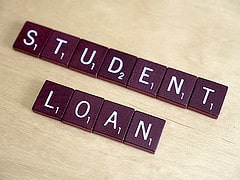
Defaulting on Student Loans
If you fail to make full payments on your federal student loans for over 270 days (nine months), you’re in default. If you make a partial payment or two, that’s not enough to keep you out of default. You can’t go more than 270 days without your account being completely current. Default is a serious issue and you’ll have to address it. Going into default wreaks havoc on your credit score and makes it nearly impossible to make any major purchases, such as cars or a home, that require good financial standing. Going into default may also make you ineligible for certain government jobs and unable to get more student loans for grad school. It makes you ineligible to switch your loan over to an easier repayment plan. Finally, it can lead to wage garnishment and revocation of professional licenses.
What Can I Do If I Default On My Student Loan?
Even if you find yourself faced with the harsh consequences of student loan default, all is not lost. You still get one chance to remove the default from your credit reports by going through student loan rehabilitation. This one-shot option allows defaulted borrowers to dig their way out of student loan default and have it wiped clean from their credit report. You can only rehabilitate a student loan one time – after that, you’re on your own.
Rehabilitation involves making nine payments (some as low as five dollars per month depending on income) during a ten-month period. These ten payments must be of a reasonable amount, voluntary (not made through wage garnishment or any other form of collection), and on time (within twenty days of the due date). Once these payments have been completed, the borrower’s repayment status can be restored, and they can choose a better repayment plan with which to get out of debt. You may also be eligible to apply for loan benefits such as loan forgiveness, deferment, more federal student loans, and forbearance once you’re out of default.
Student loan rehabilitation is serious business. If you fail to make all of your payments on time, you can fall back into default and there is no second chance for getting that expunged from your credit. In order to ensure that this does not happen, make sure that all of the documents detailing your payment plan are in order. If anything comes up down the line, you need to be prepared to consult your records to defend yourself. It is also highly recommended that you fill out a written application provided by the US Department of Education when you are working on your student loan rehabilitation rather than making a verbal agreement over the phone. That way you have clear physical records to refer to.
How Much Will I Have To Pay To Rehabilitate My Student Loan?
Consider your repayment options carefully. What may be a reasonable repayment amount for one borrower might be too much for another. Your rehabilitation payment is required to be an affordable amount based on your current income. There is an official minimum payment of $50 per month, but you may qualify for certain exceptions. The guarantee agency must consider all sources of income, including child support, workman’s compensation, Social Security benefits, veteran’s benefits, and welfare. “Reasonable and necessary expenses,” such as food and housing, are also taken into account. If you are unable to afford the payment amount that you are given, negotiate with the collector that you are working with. You may be eligible to pay less than the $50 dollar minimum if it is not reasonable and affordable for you to pay that much.
Keep Records!
Your collector is not the one who will go into default if they make a mistake in their records, so make sure to keep a record of all of your payments. Keep copies of any documents or receipts that prove that you have made your payments on time. Even if your collector is the one who made a mistake, you’re the one who will suffer if you can’t show that they’re wrong.
Even after your loan rehabilitation, you should continue to keep a careful record of your payments. You still need to be able to prove at any time that your account is current. If you can’t and there is an error in the lender’s records showing that you haven’t paid, you may face a second default. With a second default, of course, there is no second chance for rehabilitation.
You should also continue to keep tabs on your credit and be sure that the default is removed from your report after you complete student loan rehabilitation. The default must be removed after you complete rehabilitation, but credit bureaus can make mistakes just like lenders can. A default on your credit report can make it nearly impossible to get a loan for a car, home, small business, or any other purpose. It can even make it hard to get a cell phone plan or lease an apartment.
Second Defaults, Second Chances
While there is no second loan rehabilitation after a second default, you still have options. If you make three voluntary, full, on-time payments on your defaulted loan, you may be eligible to have your loan consolidated into the Direct Loan Program. Loan consolidation allows borrowers to combine the balances of their federal loans and pay them off as a single loan at a fixed rate of interest. However, this option generally unavailable to borrowers whose payments are currently in dispute. You can avoid a lot of trouble by maintaining a spotless record after fulfilling your rehabilitation.
Need Help With Student Loan Repayment?
If you’re facing default or have already defaulted on your student loans, you need to know that you have options. Contact one of our experienced local attorneys today for a free consultation to learn more about your options for loan repayment and handling default.
